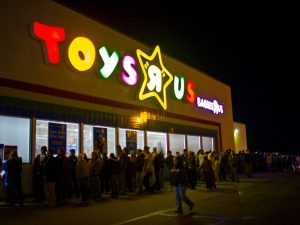
Uh oh, Geoffrey’s in trouble at Toys ‘R’ Us
With Christmas on the horizon, a US bankruptcy judge has OK’d a loan (said to amount to over $2billion) to help stabilise the chain and see it through the festive period, which is when the retail giant does most of its business.
Facts about Toys ‘R’ Us
In the UK we might imagine that Toys ‘R’ Us is a relatively new phenomenon that grew out of the 90s. In fact, the first Toys ‘R’ Us was opened in the USA 1957 by Charles Lazarus who already owned a baby furniture store in Washington. Toys ‘R’ Us was floated on the stock exchange for the first time in 1978, and expanded rapidly in the 1980s. The chain was bought by private equity investors for $6.6bn in 2005, and sales peaked at $13.9bn in 2012.
The Toys ‘R’ Us chain currently has 1,600 stores and 64,000 employees.
What’s gone wrong for Toys ‘R’ Us?
The first problem for Toys ‘R’ Us is that it has never really recovered from its costly 2005 equity takeover. The chain has sought to refinance on a number of occasions, but this has always been a temporary measure. Total borrowings to refinance the company have generated an interest bill of $400m a year, which would buy an awful lot of Barbie dolls.

Toys ‘R’ Us needs modernising
The interest payments have compounded the ability of Toys ‘R’ Us to re-invest in its business. That means stores have started to look shabby and dated, and their online presence has been negligible.
Increased competition is another factor hampering Toys ‘R’ Us, not least because increasing numbers of supermarkets sell affordable toys, which means it’s convenient for parents to add a few things to the trolley and saves them a trip to another store. Think how appealing this is for families who are time poor and financially not well off either.
Particularly online, where sales are at record levels. GlobalData Retail estimates that in 2016 about 13.7% of all toy sales were made online, which was up from 6.5% on five years previously. It appears to be the same old story, that businesses that do not move with the times, and use the new channels that are opening up (online websites, social media etc.), get left behind (Woolworths, British Home Stores etc.). And of course there is the behemoth that is Amazon. Figures suggest that Amazon doubled its profits on sales of toys and baby products in the US in 2016 and that will have been at the expense of many independent retailers and SMEs, who cannot possibly compete with volume.
So, while Toys ‘R’ Us was once a dominant player in the US toy market, it has struggled against larger rivals such as Amazon and Walmart.

Another thing to take into consideration when considering the downfall of Toys ‘R’ Us is buyer behaviour. There are mixed messaged about people’s buying habits. What is obvious is that consumer habits are changing. The out of town shopping centres with huge hypermarkets, furniture warehouses, and enormous toy stores are just not as attractive as they once were.
Some experts claim that more convenient in-town locations are seeing a resurge in sales, for example, groceries in convenience shops, although sales on the high street seem to tell a different story. Online sales are boosted year on year, but there doesn’t seem to be any research into whether people are spending more or less than they were in previous years. It may well be that there is less money around for items such as toys than there once was. People have a finite amount of money in their pockets.
A number of traditional US retailers have run into trouble recently, with declining sales and heavy losses in well-known chains such as department chain store Sears, which has closed more than 100 stores, and other department stores, such as Macy’s, which also owns Bloomingdales, that has also witnessed sales slide.
Toys ‘R’ Us in Europe
At this time, none of the chain’s European outlets are part of the bankruptcy proceedings (which are just limited to the USA and Canada). There shouldn’t be any immediate impact on the UK stores in the near future, although this may change of course. Stores in Australia and Asia are also unaffected.
Debt protection
Toys ‘R’ Us have played a canny move by filing for bankruptcy protection. What this means is that suppliers will continue to send the chain their products, as they are guaranteed payment. When rumours started spreading at the beginning of September that Toys R Us was struggling, within one week nearly half of its suppliers had refused to ship goods unless the retailer could pay cash on delivery. Imagine what that could do to a company with no cash reserves? Toys ‘R’ Us makes 40 per cent of its annual sales in the run up to Christmas.
Now with $3.7bn protection, suppliers are guaranteed payment for stock in the run-up to Christmas. This is vitally important for many suppliers, because the loss of Toys ‘R’ Us would have a huge knock on effect elsewhere. Danish toy giant Lego, for example, let 1,400 employees go after suffering its first drop in sales in more than a decade. Having survived bankruptcy itself just 15 years ago, it will want to protect declining sales.
The future for Toys R Us
Toys ‘R’ Us intend to use the bankruptcy process to restructure management, and make the company viable again for the future. It needs to consolidate its enormous debts (said to be in the region of $5bn of long-term debt). The company is also looking to online sales to secure its future, and has recently launched web stores for all its products.
But what can it do to make toys cool again? It seems that once children outgrow their dolls, teddies and train sets, they trade them on for electronic devices: tablets, phones, gaming systems and iPads. Children are abandoning toys at a younger and younger age, in favour of a small screen.
Over to you
What are your thoughts about Toys ‘R’ Us? How can SMEs withstand the pressures of the huge giants? Add a comment below or come and join the conversation on Facebook.

Can Geoffrey and his colleagues survive after Christmas?
 Wholesale
Wholesale
2 Responses to “The Rise and Fall of Toys ‘R’ Us”
I just sell to friends
Prices are to high and staff still need to smile, even though there not dealing with anyone. We still see them.